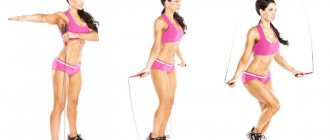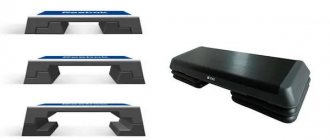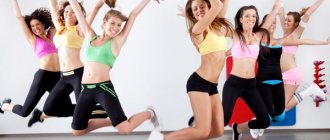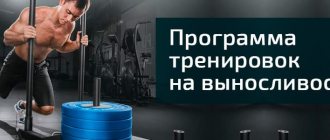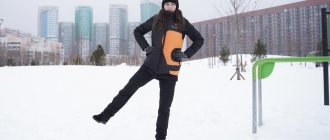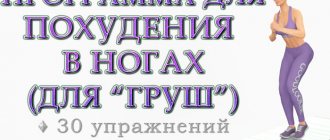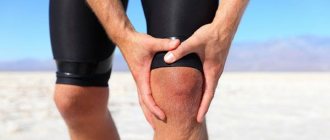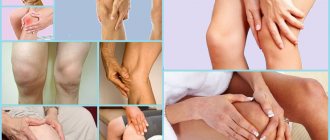All coordination ladder exercises are aimed at improving coordination and footwork speed, movement technique and balance.
As with many technique exercises, the correctness of execution is more important here than the speed of execution. First you need to learn to do it right, and then learn to do it right and at the same time - quickly.
Constant and sudden changes in game situations require young players to be extremely focused, quick to react, keen attention, the ability to quickly react to the actions of opponents and partners, quickly assess the game situation, instantly make a tactical decision and immediately implement it. To develop the above-mentioned physical qualities, the training system uses a wide arsenal of general physical training means, one of them is a coordination ladder (speed ladder, agility ladder), which helps the players develop the physical qualities necessary for gaming activities (speed and agility). There are many exercises with the coordination ladder, here are some of them.
Exercises with coordination ladder
Exercise No. 1 - “hopscotch”
• * Start the exercise by taking your starting position at the bottom of the stairs, with your feet shoulder-width apart. • * Jump forward, pushing off with both feet, and land in the first sector of the stairs on your left foot. • * Next, pushing off with your left foot, jump forward again, but land on both feet. • * We push off with both feet again, jump forward and land on our right foot. • * Using only the right foot, we jump forward and land on two feet. This is 1 cycle. Repeat this cycle until the ladder ends.
Exercise No. 2 - “inside-out”
• *Start the exercise by placing your feet shoulder-width apart at the front of the stairs. • * Step (not jump, just walk) into the first section of the stairs, first with your left and then with your right foot. • *After placing your right foot in the first section, immediately place your left foot to the left of the next section of the ladder, then your right foot to the right of the ladder. • * Again, step your left foot inside the stairs, and then also step your right (as if returning to the previous position). • * Repeat this movement pattern until the ladder ends.
Exercise No. 3 - “step to the side”
• * Start the exercise by positioning yourself near the lower left corner of the stairs (previously we started the exercise in the center, but now you need to move a little to the left). • * Step into the first section with your left foot, and without stopping, immediately step there with your right (as if you were doing a jump, or a jump stop; in the original this movement is called “1-2 motion”, minimize the time between each step). • * Now you need to move to the right of the current section, again placing your left foot first and then your right foot. • * Now step diagonally to the left and up, again using first your left and then your right leg. • * Move to the left, leaving the stairs, first with your left and then with your right foot. So we find ourselves in the starting position. • * Continue in the same manner until the end of the stairs. If you decide to do this exercise several times, start on the opposite side of the stairs each time, this way your leading leg (in the example, the left leg) will change regularly.
Exercise No. 4 - “Tango”
• * Start this exercise by standing at the bottom left of the stairs (like the previous exercise). • * Step your left foot over your right foot and stand in the middle of the first section. • * Next, without stopping, place your right foot at the level of the crossbar between the first and second sections, and immediately place your left foot next to your right. • * This exercise is performed on a 1-2-3 count, as in a dance. • * From this position, the right leg steps over the left and stands in the center of the second section of the ladder, then the left leg.
Exercise No. 5 - “Five Steps”
This is the most difficult exercise of all presented here; to perform it you will need a very high level of training and innate dexterity. But if you learn to perform this exercise smoothly, without faltering, and at high speed, most of your opponents simply will not be able to keep up with your movements. • * Starting position - feet shoulder-width apart, standing in front of the stairs in the center. • * Place your right foot to the right of the first section of the stairs, almost simultaneously place your left foot in the first section of the stairs. • * The right leg moves towards the left, after which the left moves into the second section (i.e. steps forward), and the right follows. • * The movement consists of 5 steps - this is the first phase. The second is almost similar to this one, but the movement begins with the left leg. The exercise must be repeated along the entire length of the stairs. (Exercises to develop agility, speed and footwork
On the topic: methodological developments, presentations and notes
In this article, the exercises and their dosage are given only for the performance of boys in grades 10-11. I’ll say right away that perhaps some people will think the applied load is too great. However, young men from .
The speed ladder is equipment from the SAQ training system. it is used in physical education lessons and in sectional work.
Development of speed endurance at the stage of initial training in basketball.
Abstract – cross-country skiing includes a lot of disciplines, one of them is sprint competitions, which include individual and team sprints. Qualified skier.
Abstract – cross-country skiing includes a lot of disciplines, one of them is sprint competitions, which include individual and team sprints. Qualified skier.
The material contains training methods aimed at developing speed and general endurance, speed, and gaming dexterity of 7th grade students in sports games based on football.
Report on the topic: “Training speed and speed endurance in young football players” by a teacher of additional education at the Children’s and Youth Sports School of the Teuchezhsky District.
Working with your hands
When doing footwork speed exercises to increase your running cadence, arm work is just as important as footwork. It is impossible to run with your legs moving at one speed and your arms at another. The speed should be the same; accordingly, the arms need to be trained simultaneously with the legs and preferably with the required amplitude.
In more complex exercises, where the movements are directed in different directions, but the legs work alternately as when running, more active work with the arms helps to “catch” the rhythm and makes the exercise easier. In some exercises, the arms act as a balancer, allowing you to perform the exercises more sharply and actively. With your arms hanging or clenched into fists at chest level, there will be no balancer.
Special physical training
Special physical training is aimed at developing motor skills and abilities (speed, speed-strength, coordination abilities, special endurance). Special training can be carried out both on the ice and off the ice. Off-ice training is called specialized training. As preparation, special exercises are used for neuromuscular efforts, spatial-temporal characteristics and operating modes adequate to the basic hockey movements. Such exercises include exercises from the technical and tactical arsenal of hockey and special preparatory exercises developed on their basis. The amount of special physical training means is significantly less than general physical training. During training, both complex and selective influences are provided on the physical qualities and abilities of hockey players.
These two types of training are closely related and complement each other. Physical training is closely related to other types of training: technical, tactical, psychological. Exercises that develop various types of endurance at the same time cultivate the moral and volitional qualities of hockey players: the ability to perform work in conditions of increasing fatigue through “I can’t”, instill hard work, etc. In the modern training process, the method of complex influence is widely used, which allows simultaneously improving special skills. physical and technical-tactical readiness, as well as game thinking of hockey players.
Physical training of hockey players is ultimately aimed at improving health, strengthening the musculoskeletal system, harmonious development of the body, increasing the capabilities of the cardiovascular and respiratory systems, and comprehensive development of motor qualities and coordination abilities.
For beginning hockey players, physical training should be aimed primarily at: improving natural coordination of movements; economical execution of certain elements of movement, development of abilities for various forms of movement, comprehensive development of motor qualities, maximum achievement of results with minimal energy expenditure, development of the ability to overcome the resistance of an opponent when performing certain elements of gaming activity; increasing the development of strength, speed, endurance, flexibility and coordination.
Hockey players acquire and create the prerequisites for effective mastery of new, more advanced motor skills and abilities as they develop strength, speed, endurance, agility, flexibility, and coordination. The high performance of hockey players provides the necessary and harmonious development of all the qualities necessary for an athlete. A high level of physical fitness, achieved through many years of training, allows hockey players to solve the problems of technical and tactical training more effectively and is a necessary prerequisite and basis for achieving high and stable sports results.
Center of gravity height
Almost all changes in direction of movement are associated with a lower center of gravity. Try to do these exercises not on straight legs, but on bent ones - this will make it easier for you to apply the acquired skills in the game. • • Be sure to warm up before performing exercises. • • Perform this program 2-3 times per week (minimum 48 hours between workouts). • • “L” and “R” means that you do the exercise first with one leg in front (left) and then again with the other (right) leg in front. • • “x 2” means do 2 sets. In this case, one approach is to walk up the stairs in one direction and back. • • Rest 30-60 seconds between sets, depending on how quickly you recover. • • Proper technique is more important than speed, take your time. First achieve good performance, then gradually increase the speed (Exercises with coordination ladder
Self-production of the device
Today on the sports equipment market you can purchase such a sports simulator under a variety of names. For example, a coordination track, training ladder or agility ladder. But, as a rule, they are quite expensive, and their design does not present any difficulties. Therefore, having all the necessary materials, such a device for physical exercise can be made with your own hands at home.
Necessary materials:
- PVC pipe blanks: diameter - 2 cm, length 40 cm (to make eleven crossbars you will need 4 linear meters of PVC pipe);
- polypropylene household cord: diameter - 0.7 cm, length - 20 m;
- set of cable ties - 25 pieces, size 3*100 mm;
- a small piece of metal wire.
The design of the sports device is quite simple. Therefore, doing it yourself will not be difficult and will not take much time.
Instructions for assembling a 4.5 meter long floor training ladder:
Using a homemade device
A homemade sports ladder can be used for physical exercise on the surface of the ground, on an asphalt area or in the gym. The ladder unfolds to its full length on any horizontal surface. A whole group of athletes can alternately exercise on the simulator at the same time, performing different exercises.
When working with such a simulator, it is important to diversify the training loads and ensure a positive emotional tone. If you constantly do the same exercise, it begins to become boring, and after a few approaches it is already performed without enthusiasm. And to get the maximum effect, classes should give athletes pleasure not only after overcoming any difficulties, but also from the movements themselves.
The parameters of the high-speed projectile cells are selected by specialists so that all elements of movements are practiced with the required frequency and amplitude.
Recommendations from sports trainers:
- To warm up, it is recommended to select 7-8 different exercises and do each one once, but without a break. You can take 2-3 exercises, and also do each 2 times without a break.
- The best option for training is 3-4 exercises. Each of them should be performed 5-15 times depending on the athlete’s preparation. Between approaches you need to take 2 minute rest breaks. This will be enough for a one-time workout.
When performing exercises, the head should be slightly raised, the gaze should be directed only forward, but not at the ground or floor. It is also recommended to include exercises with elements of rotation up to 360 degrees in complex classes. The more there are, the better.
